Point soldering targets individual components with precise heat application, ideal for small-scale or intricate assemblies, while wave soldering uses a continuous wave of molten solder to simultaneously bond multiple connections on a PCB, increasing efficiency for mass production. Explore the rest of the article to understand which soldering method best suits your specific project needs.
Comparison Table
| Criteria | Point Soldering | Wave Soldering |
|---|---|---|
| Process Type | Localized soldering at specific points | Continuous soldering using a wave of molten solder |
| Application | Single joints or small-scale repairs | Mass production of printed circuit boards (PCBs) |
| Speed | Slower, manual or semi-automatic | Fast, fully automated |
| Suitability | Best for intricate or delicate components | Ideal for through-hole components on PCBs |
| Cost Efficiency | Less efficient for large batches | Highly cost-effective for mass production |
| Soldering Quality | Precise, controlled solder joints | Consistent soldering but with higher risk of bridging |
| Equipment | Simple soldering iron or station | Specialized wave soldering machine |
Introduction to Point Soldering and Wave Soldering
Point soldering involves joining individual components to a printed circuit board (PCB) by applying solder to specific points using a soldering iron or soldering gun, allowing for precise and controlled connections. Wave soldering is a mass soldering process where the entire underside of a PCB is exposed to a wave of molten solder, efficiently soldering multiple connections simultaneously, commonly used for through-hole components. Both techniques are fundamental in electronic manufacturing, with point soldering suited for small-scale or repair tasks and wave soldering optimized for high-volume production.
Understanding the Basics of Point Soldering
Point soldering is a precise technique used to join specific components by applying solder to targeted areas, ensuring strong mechanical and electrical connections. Unlike wave soldering, which simultaneously solders multiple connections by passing the assembly over a wave of molten solder, point soldering allows for greater control on individual joints and is ideal for delicate or complex circuit board designs. This method reduces the risk of bridging and overheating sensitive components, making it essential for applications requiring high reliability and precision.
Wave Soldering Explained: Process and Applications
Wave soldering involves passing a PCB over a continuous wave of molten solder, enabling efficient simultaneous soldering of multiple electronic components. This process excels in high-volume production of through-hole assemblies, ensuring consistent solder joints and reduced defects. Your manufacturing efficiency benefits from wave soldering's ability to handle complex boards with speed and reliability.
Key Differences Between Point Soldering and Wave Soldering
Point soldering targets specific components or connections by applying heat and solder to a localized area, ideal for precision work on individual joints. Wave soldering involves passing an entire printed circuit board (PCB) over a wave of molten solder, efficiently soldering multiple joints simultaneously, making it suitable for mass production. Your choice between these methods depends on factors such as component density, production scale, and the desired soldering accuracy.
Advantages of Point Soldering in Electronics Manufacturing
Point soldering offers precise control over heat application, reducing the risk of thermal damage to sensitive electronic components in manufacturing. This method enhances joint reliability by ensuring consistent solder quality at each connection point. It also minimizes solder waste and enables efficient automation, making it ideal for complex or mixed-technology circuit boards.
Benefits of Wave Soldering for PCB Assembly
Wave soldering offers superior efficiency for large-scale PCB assembly by simultaneously soldering multiple components, reducing production time significantly compared to point soldering. It provides consistent, high-quality solder joints ideal for through-hole components, enhancing reliability in mass production. The automation of wave soldering minimizes human error, resulting in fewer defects and improved overall manufacturing yield.
Common Challenges in Point Soldering vs Wave Soldering
Point soldering faces challenges such as inconsistent heat application and difficulty maintaining uniform solder joints, leading to potential cold solder defects. Wave soldering commonly encounters issues with solder bridging and insufficient wetting, especially on complex PCB layouts or densely populated boards. Both methods require precise thermal profiles to minimize defects and ensure strong, reliable electronic connections.
Cost Comparison: Point Soldering vs Wave Soldering
Point soldering typically incurs higher labor costs due to its manual or semi-automated process, making it suitable for low-volume production or repairs. Wave soldering offers lower per-unit costs by enabling rapid, automated soldering of entire circuit boards, ideal for high-volume manufacturing. Your decision should consider production scale and cost efficiency, favoring wave soldering for mass production and point soldering for specialized or small-batch tasks.
Choosing the Right Method for Your PCB Project
Point soldering offers precise control, making it ideal for small batch PCB projects or sensitive components that require targeted heat application. Wave soldering excels in high-volume production, providing fast and consistent soldering for through-hole components on uniform board layouts. Selecting the appropriate technique depends on factors like production scale, component complexity, and thermal sensitivity to ensure optimal solder joint quality and efficiency.
Future Trends in Soldering Technologies
Point soldering and wave soldering technologies are evolving with increasing emphasis on precision, automation, and environmental sustainability. Future trends highlight the integration of AI-driven robotic systems to enhance accuracy and repeatability while minimizing defects and material waste. Your production efficiency will benefit from advancements in lead-free solder alloys and energy-efficient heating methods that comply with stricter environmental regulations.
Point soldering vs wave soldering Infographic

 solderic.com
solderic.com